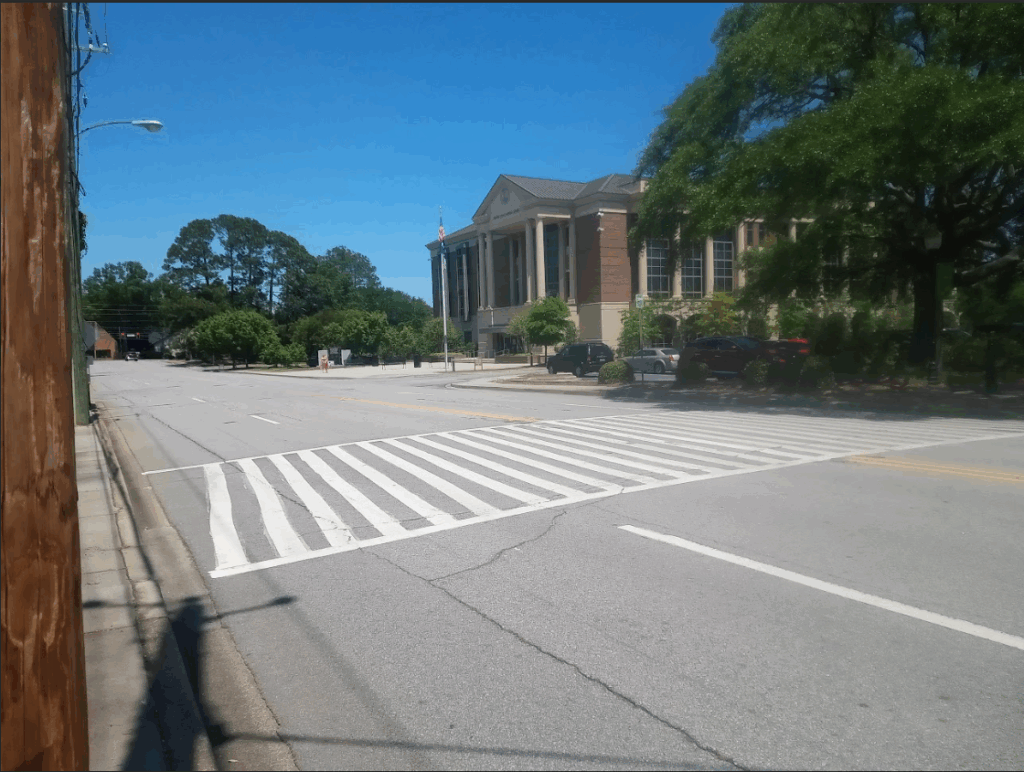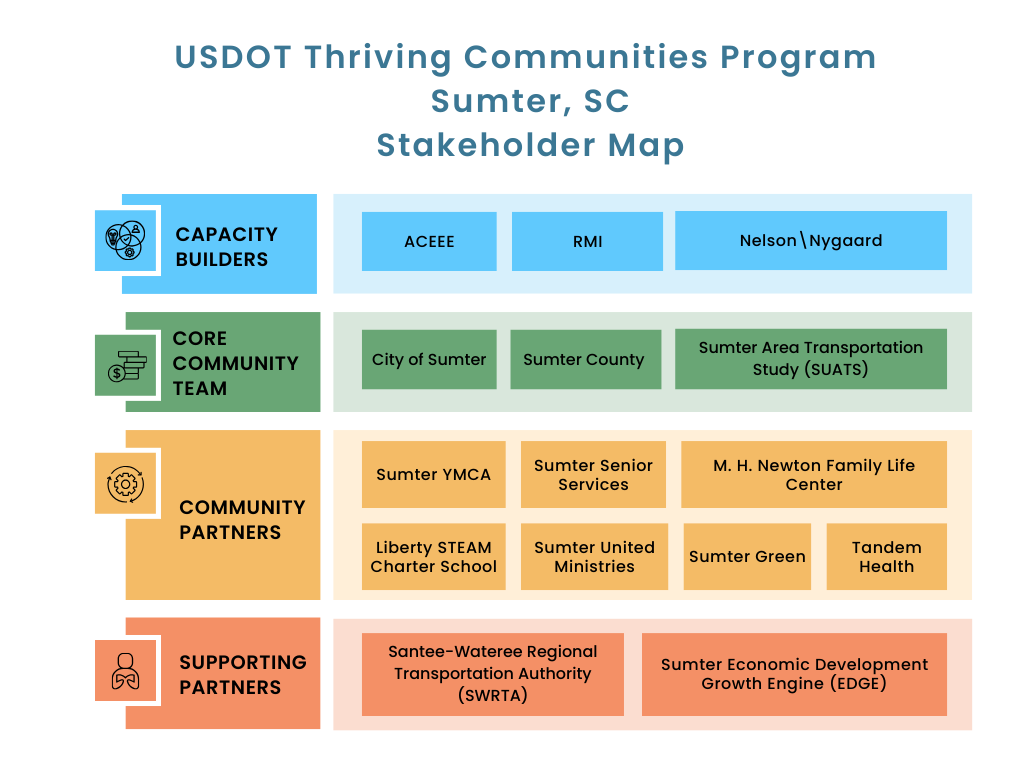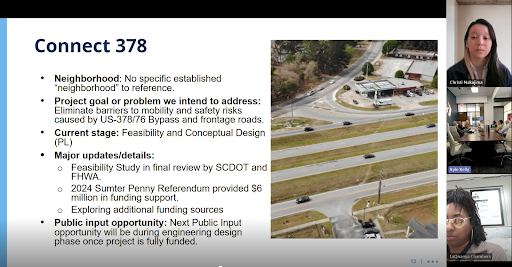USDOT Thriving Communities Program: Sumter, SC
15 minutes Date Launched/Enacted: May 21, 2025 Date Published: May 19, 2025

About the Thriving Communities Program (TCP)
The Thriving Communities Program (TCP) funds tailored technical assistance to under-resourced and disadvantaged communities, helping them better access historic infrastructure investments and deliver transformative projects. The USDOT FY 2022 Thriving Communities Program supports 64 communities across the country with access to a team of capacity builders to develop innovative community engagement methods, identify funding opportunities, and grow long-term capacity to develop and deliver transportation projects that strengthen communities.
TCP Complete Neighborhoods Community of Practice
TCP Communities are grouped into three Communities of Practice: Main Streets, Networked Communities, and Complete Neighborhoods. The 15 communities included under the Complete Neighborhoods Community of Practice are:
| Atlantic Beach, SC | Isabela, PR | Santa Cruz, CA |
| Billings, MT | Lansing, MI | St. Louis County, MO |
| Decatur, IL | Lima, OH | Suffolk, NY |
| East Orange, NJ | Providence, RI | Sumter, SC |
| Indianapolis, IN | Roanoke, VA | Waukegan, IL |
The US Department of Transportation (USDOT) selected a capacity building team led by RMI, including: the American Council for Energy-Efficient Economy (ACEEE), Equitable Cities, Nelson\Nygaard, and the Shared-Use Mobility Center (SUMC), to provide technical assistance to these 15 communities.

A Snapshot of Sumter, South Carolina
ACEEE is the lead in the Capacity Building team for the Sumter Area Transportation Study (SUATS), the Metropolitan Planning Organization for the Sumter region. SUATS applied to participate in the Thriving Communities Program with the intent of strengthening public engagement processes, improving readiness to partner with state and federal funders, and obtaining more funding for public transit.
The SUATS region represents a 225 sq. mi. portion of Sumter County, which also encompasses the City of Sumter. Sumter faces several challenges related to transportation safety and access. According to the U.S. Census Bureau, within Sumter County, 1 of every 12 households do not have access to a car. Within the City of Sumter, that rate jumps to 1 of every 9 households. For these households, the lack of travel options can present a major barrier to accessing essential destinations such as grocery stores, medical offices, and jobs. Further, Sumter has almost double the national average of fatalities per 100,000 people over the past 10 years. An average of 22 people have been killed every year by vehicle crashes in Sumter County over the past 10 years.
SUATS and local partners are working to address these issues by implementing traffic calming measures, constructing bicycle and pedestrian infrastructure, and exploring strategies to increase funding for public transit. Santee-Wateree Regional Transportation Authority (SWRTA), the primary provider of public transit in Sumter, runs fixed route, paratransit, and commuter services. However, a lack of local match funding means that federal dollars are often left on the table, leaving SWRTA unable to expand its service or introduce new routes. Furthermore, despite significant efforts to solicit public input on roadway reconfiguration and safety projects, in most cases only a handful of residents attend public meetings and provide feedback. SUATS and local partners sought new and effective ways to reach a broader segment of the community.
Key Partners
The Capacity Building team engaged with several key partners throughout TCP. These partners included:

Activities through the Thriving Communities Program
Creating a New Resident Advisory Committee
In response to the need for more robust public engagement processes, the Capacity Building team guided SUATS and City of Sumter staff in developing a list of community-based organizations (CBOs) in Sumter. The Capacity Building team supported their outreach to contacts at these CBOs, inviting them to participate in a temporary steering committee which would convene with the goals of providing input on upcoming transportation projects, advising on a long-term strategy for comprehensive public engagement, and pulling other CBOs into this effort.
Over the course of seven meetings, committee members offered their thoughts on transportation-related challenges that they’d like to see addressed, asked questions about upcoming projects, and provided ideas and feedback on proposals around future public engagement strategies. The following CBOs attended the majority of steering committee meetings:
- Liberty STEAM Charter School
- Sumter YMCA
- Sumter United Ministries
- Sumter Senior Services
- M. H. Newton Family Life Center
- Sumter Green
- Tandem Health
After the first few meetings, SUATS and the City of Sumter developed an issue tracker in the form of a spreadsheet, which contains the problems raised by the committee, the identified solution (if any), the status of solution implementation, and next steps. One of the issues raised was the lack of lighting at the intersection of McCray’s Mill Road and Pinewood Road, which created a safety risk for residents at a high growth intersection that had recently been reconfigured by a major SUATS project. Before the final committee meeting, the City worked with Duke Energy to install two overhead lights at the intersection. Committee members appreciated the responsiveness of government staff, as well as the opportunity to connect with other CBOs in the region.

A steering committee meeting facilitated by ACEEE and local and regional government partners. Most committee members attended in-person, but a virtual option for joining was also provided. Credit: ACEEE
Based on feedback from the committee, the Capacity Building team and local government partners decided to establish a permanent resident advisory committee that would provide the resident perspective in advising SUATS’s policy committee, which makes decisions about project planning and funding. SUATS bylaws were amended in early 2025 to create this committee, and the first meeting will take place after the policy committee appoints members to the resident advisory committee.
Leveraging Existing Assets to Generate Revenue for Public Transit
Currently, local funding commitments for public transit in Sumter are not sufficient to leverage the maximum amount of federal match dollars available to SWRTA via the FTA Section 5307 program. As part of a multi-pronged effort to add additional resources and enhance area transit services, SUATS and SWRTA developed a plan to tap into a new source of local funds with support from capacity builders. SWRTA owns the James Clyburn Intermodal Transportation Center, which contains several shell spaces that were built to be leased to third parties for compatible commercial uses but were never finished. SWRTA and other local partners are working to prepare the available spaces in the Clyburn Center to be leased so the lease funds can generate revenue for future transit service improvements and expansion.
Funding will be needed to complete renovations to make the spaces marketable. Complicating these efforts was a history of confusion regarding the Federal Transit Administration’s (FTA) role with regard to eligible use of the building, as development of the Clyburn Center was supported by federal funds. With limited records of that original agreement and guidance, SUATS and SWRTA requested support from the Capacity Building team to understand current FTA guidance and identify funding sources for renovations. The team confirmed that under joint development guidelines, SWRTA should be able to renovate and lease spaces within the Clyburn Center. The team also developed a detailed list of potential federal and non-profit funding sources for local partners to consider.
Additionally, direct funding through TCP allowed capacity builders to contract with Sumter Economic Development Growth Engine (EDGE) to hire a local architect to help move planning forward. The architect developed preliminary plans for the Clyburn Center, including construction cost estimates and base floor plans/elevations. This moved SUATS and SWRTA closer to completing the necessary upfits. With respect to more direct improvements to the transit ridership experience, capacity builders contracted with a design firm to develop updated transit stop signage designs for SWRTA.

The James Clyburn Intermodal Transportation Center, which houses the administrative offices for SWRTA in addition to shell spaces like the one above. Credit: SUATS
Developing a Resilience Chapter and Report Card for the Long Range Transportation Plan
Due to the natural hydrology of the area, flooding is a significant challenge for the Sumter region. However, neither the City of Sumter nor SUATS have a dedicated environmental resilience plan as part of a larger plan or as a standalone product. SUATS has identified projects that will help mitigate flooding from heavy rainfall events, but has not yet placed those projects within the Long Range Transportation Plan (LRTP), which is intended to guide transportation investments over the next 25 years. Further, the organization does not yet have a mechanism to rank or prioritize these projects. SUATS is drafting a resilience chapter to include in the LRTP via amendment, but needed support on key elements to include and best practices for developing an effective plan.
The Capacity Building team conducted a literature review of other MPOs’ resilience-related plans and goals, and used this to develop an outline, annotated with references to these plans, best practices, and key considerations, that will provide the foundation for the full resilience chapter that will be drafted during the summer and fall of 2025.
Additionally, the LRTP contains a list of action items linking to policy goals related to various transportation categories, including roadway, bike and pedestrian, public transit, and freight. SUATS sought to develop a report card to display these action items and their current status in a standalone, easy-to-digest format. The goal of this report card is to improve accountability and facilitate a stronger understanding among stakeholders of where each action item stands. The Capacity Building team provided feedback on a draft report card developed by SUATS, including input on terminology, categorization, identifying a lead agency, and how to make certain action items more measurable. Capacity builders also created a designed template for the report card that can easily be updated and printed for distribution to stakeholders. The report card will be considered with intent to adopt by the SUATS policy committee following the conclusion of TCP.
Other Initiatives
Direct funding available through TCP enabled capacity builders to contract with a local landscape architect, who developed master landscaping plans for community entryways. These plans will enable the city to visually enhance various segments of the community with natural elements. Additionally, capacity builders supported the city by providing feedback on their RFP, which sought to identify and hire a consultant to develop the city’s Safe Streets for All Safety Action Plan.
Finally, in 2008, Sumter County voters approved a 1% sales tax, known as the “Penny for Progress”, to fund 16 capital projects. The tax was renewed in 2014 to fund an additional 22 projects. In 2022, efforts to renew the tax a third time failed by just over 400 votes. Team Sumter reviewed those results and initiated a comprehensive effort to develop new projects and educate voters on the need for the local investment, and presented the tax referendum again in 2024, where it was approved by an overwhelming margin. Among a full list of 30 capital projects, revenue collected from the 2024 tax in Sumter County over an eight-year period will fund transportation projects, including intersection safety improvements, street resurfacing, a project to reimagine the US-378 bypass on the northern boundary of the City, and new sidewalks and sidepaths. Capacity builders supported SUATS and local partners in soliciting input on these projects from community members and developing renderings to help visualize them.

Shot Pouch Greenway, a 3.1-mile multi-use path connecting Dillon Park with Swan Lake-Iris Gardens, was funded by the 2014 Penny for Progress Initiative. Today, residents enjoy walking, running, biking, and more along the greenway. Credit: ACEEE
Related Resources
Capacity building efforts through the Thriving Communities Program are continuing until May 2025. The Capacity Building team will conduct more technical assistance activities and will update this case study as the program progresses.